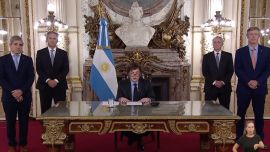The show is built from the collection of the Museo Nacional Centro de Arte Reina Sofía, Madrid, and focuses on Miró’s later work, during which the vivid and striking creations so typical of his visual language blend with near-abstract works. Although this late chapter of Miró’s creative life tends to be eclipsed by his more famous works of the interwar and post-war periods, it was during his later years that the artist brought his painting and sculpture into direct dialogue: and this connection looms large in the concept of the exhibition on display at the MNBA.
A contemporary of Salvador Dalí and Pablo Picasso, Miró was born in 1893 in Palma de Mallorca into a family of a goldsmith and a watchmaker.
He studied both business and art but eventually settled on the latter after suffering a nervous breakdown in 1912. In 1920 he moved to Paris, where he met Picasso and other artists of theavant-garde, joining the Surrealistmovement a few years later only to then defy its tenetsand seek a more nonconformist path. His time in Paris, where he remained during the Spanish Civil War, saw him rise to fame with his visual system of symbols, constantly pushing the boundaries of art.
In 1956, Miró moved back to Spain and the works displayed at the MNBA were created in his studio in Mallorca, where he began developing a stronger relationship between painting and sculpture. In his later period, he increasingly turned his attention to refining his creative language: although references to nature, humans and animals are ever-present, he starts discardingextraneous details and his style becomes more minimalistic, more transcendental.
The MNBA exhibition will be on display until February 25, when it leaves Buenos Aires for the Museum of Arts of Lima, Peru. It comes a few years after the Reina Sofía Museum took this show of late works by Miró through the US. Unlike these previous settings, the MNBA brings all the works in one single space, allowing viewers to enjoy the curator’s vision of the fluid dialogue between the paintings and the sculptures. The viewer may look at the blurred lines and brush strokes of Miró’s 1969 Femme VI (“Woman VI”), the last in his series of Femmes et oiseaux (“Women and Birds”) and then wander to Poème à la gloire des étincelles (“Poem to the Glory of Sparkles”) of the same year, before stepping in a back alcove to see the redeemed lines and dots of Paysage (“Landscape,” 1976) or enjoying the stylised creativity of reusing materials to create the Danseuse (“Dancer”), a 1981 sculpture.
And most will stop to look carefully at his tribute to Picasso, Femme, oiseau, étoile (“Woman, Bird, Star”), a large and symbolladen canvas of vivid contrasts which Miró finished on the day of his friend Picasso’s death, after working on it for seven years (1966-1973).
“We wanted to show this joined perspective on Miró’s painting and sculpture, because it is a rare endeavour. There are always separate exhibitions focused on paintings or sculptures, but there is no record of trying to put together a show such as this, which underlines the dialogue between painting and sculpture, since they function in unity,” Reina Sofía curator Carmen Fernández Aparicio told the Times during a tour of the MNBA exhibition.
“Most of these works were created while Miró was living in Mallorca, already enjoying worldwide fame. That time on the island allowed him to retreat into an inner exile of sorts, isolating himself and focusing on his work,” Aparicio said.
Miró: The Experience of Looking is a unique show in that even Reina Sofía visitors don’t get to enjoy the Spanish artist from this collective angle.
“The museum has rooms dedicated to Dalí and Juan Gris, Aparicio agreed, but Miró is “exhibited throughout the historical timeline-based layout of the collection.”
WHEN AND WHERE
Until February 25 at the National Museum of Fine Arts (Av. del Libertador 1473). Opening hours: Tuesday through Friday, 11am to 8pm; Weekends 10am through 8pm. Free admission. More info: www.bellasartes.gob.ar























Comments